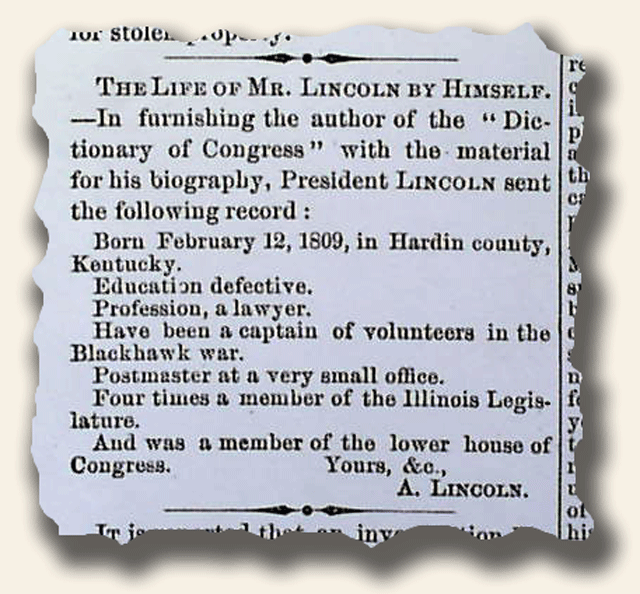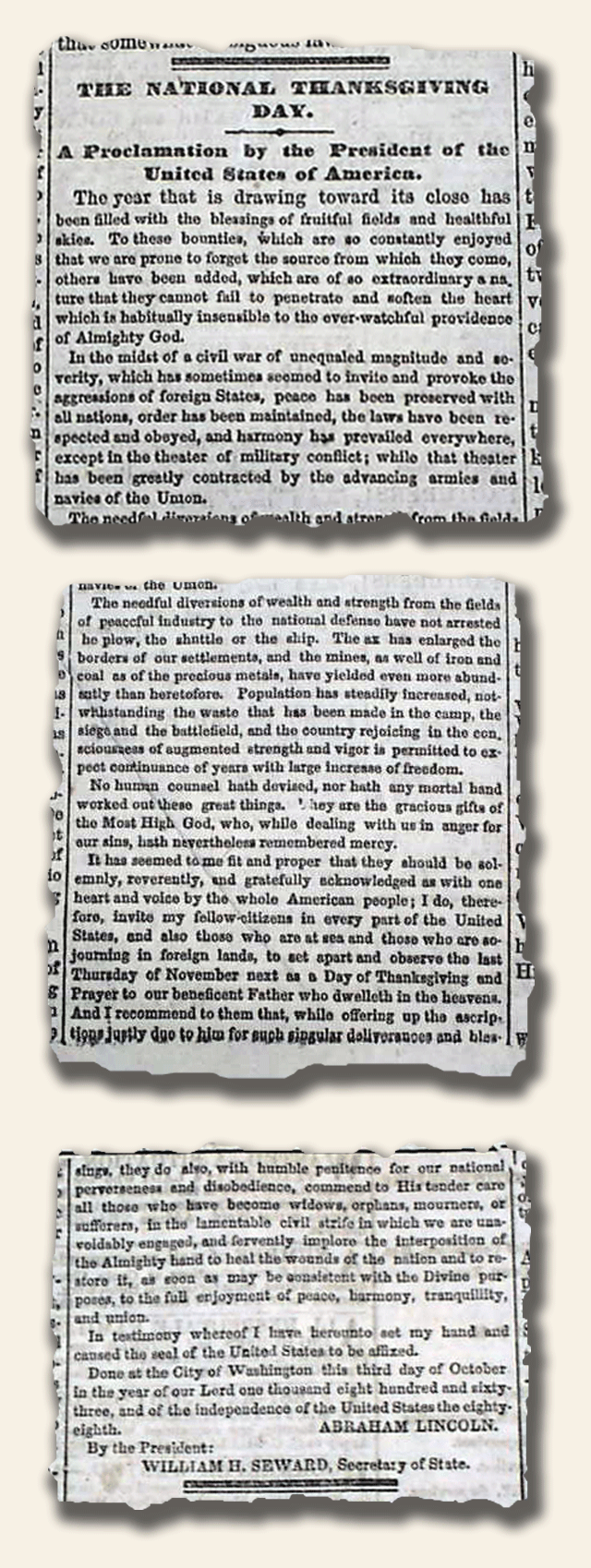Is it true?
January 15, 2011 by TimHughes · 2 Comments
The “Democratic Watchman” newspaper from Bellefonte, Pennsylvania, July 30, 1886 has an interesting tidbit which, if true, unveils what it likely a little known and fascinating twist in American history: “Jefferson Davis, as an officer in the Black Hawk war, administered the oath of allegiance to Abraham Lincoln, entering the service as a lieutenant.” (see below)
What could have been…
December 13, 2010 by TimHughes · Leave a Comment
One might wonder how some significant events in history might have been responded to had reaction been different from what the history books note. During the Civil war the “Albany Atlas” decided to fool with history a bit following the Emancipation Proclamation, and supposed a “Counter Proclamation” by the Confederate President, Jeff Davis. The article shown–which appeared in the Confederate newspaper “Memphis Daily Appeal” of January 23, 1863 (while printing in Jackson, Mississippi at the time)–makes for some interesting reading on what could have happened in history (see below).
What could happen to a rumor…
December 9, 2010 by TimHughes · Leave a Comment
“The Daily Journal” newspaper of August 20, 1861 from Wilmington, North Carolina, a Confederate publication, printed an interesting series of dispatches of a fictitious assassination attempt upon President Lincoln (see below). They provide an interesting perspective on how a dramatic event could be much less so once more trustworthy news reports found their way to the press.
The reliability of news reports was a big problem in the 18th & 19th centuries during the pre-telegraph, pre-wire service days when word of mouth was often the source of what made it into the newspaper. This somewhat comical piece illustrates a quandary likely dealt with by most newspaper publishers of the day.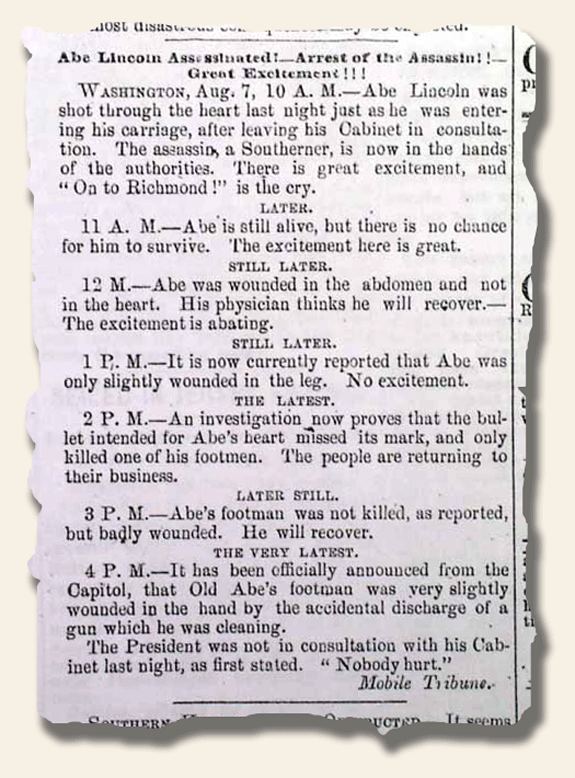
April 15, 1865 New York Herald reprints… revisited…
November 1, 2010 by GuyHeilenman · 10 Comments
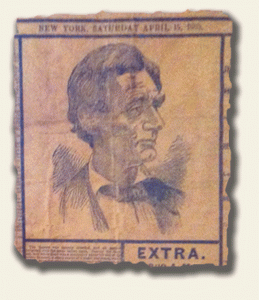 A previous post by guest contributor Rick Brown detailed how one can identify whether or not their April 15, 1865 New York Herald is authentic. One of the most notable differences between an authentic issue (which is quite rare) and one of the reprints (which are rather common) is that the common reprint has an image of President Lincoln on the front page, whereas, the original does not. We recently came across a photo of the Lincoln image (as shown to the right). If your issue has it… unfortunately, your’s is not an original.
A previous post by guest contributor Rick Brown detailed how one can identify whether or not their April 15, 1865 New York Herald is authentic. One of the most notable differences between an authentic issue (which is quite rare) and one of the reprints (which are rather common) is that the common reprint has an image of President Lincoln on the front page, whereas, the original does not. We recently came across a photo of the Lincoln image (as shown to the right). If your issue has it… unfortunately, your’s is not an original.
Recommended reading…
June 26, 2010 by GuyHeilenman · Leave a Comment
 Jim Wheeler, one of our “rare newspaper” friends, recently sent us an e-mail with the following recommendation for our summer reading list:
Jim Wheeler, one of our “rare newspaper” friends, recently sent us an e-mail with the following recommendation for our summer reading list:
The Constitutional Convention: A Narrative History from the Notes of James Madison, by Edward J. Larson & Michael P. Winship, ISBN 0-8129-7517
This book essentially condenses and annotates Madison’s notes taken throughout the Convention so that the language and the important concepts that were discussed can be understood today. The book includes a list of those attending the convention and their respective states. When you keep a 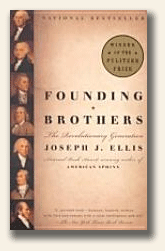 copy of this list handy while reading the notes, you can get a clear picture of the regional motives behind the discussion as the constitution was developed. This book, in conjunction with The Founding Brothers, John Ellis, were both extremely helpful in developing a working understanding of what I consider to be one of the most interesting 10 to 20 year time period in US history.
copy of this list handy while reading the notes, you can get a clear picture of the regional motives behind the discussion as the constitution was developed. This book, in conjunction with The Founding Brothers, John Ellis, were both extremely helpful in developing a working understanding of what I consider to be one of the most interesting 10 to 20 year time period in US history.
I thought that in addition to all of your other reading, these two items may be interesting and helpful.
Thanks for your suggestions Jim. To the readers of this post: “If you have a chance to read either of these (or have already done so), the community would love to hear your reactions as well.
Value of the internet…
May 13, 2010 by TimHughes · Leave a Comment
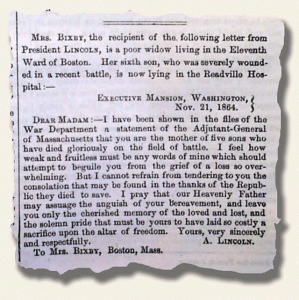 I never fail to be amazed at the incredible wealth of information which is available on the internet, and I never fail to be thankful for such an incredible resource, particularly remembering what it took thirty years ago to research a newspaper.
I never fail to be amazed at the incredible wealth of information which is available on the internet, and I never fail to be thankful for such an incredible resource, particularly remembering what it took thirty years ago to research a newspaper.
Back in the 1970’s and ’80’s, when I wrote up an issue for the catalog I had to pull out the encyclopedia if I was unsure of a specific date or consequences of a certain battle. And I also kept close at hand other resources which would document events I was finding in our inventory of newspapers.
But today, more information than I could possibly need flashes on my screen in a matter of seconds. What was the date James Buchanan died? Wikipedia tells me more quickly then it takes me to type “james buchanan”. Many times I’ll read an interesting article about a person which sounds intriguing but is lost to my memory. The web quickly provides a wealth of detail.
What brings this to mind is an entry I worked on this morning. The “Army & Navy Journal” of Dec. 3, 1864 has a touching item about a Mrs. Bixby who received a letter of condolence from Abraham Lincoln for her loss of five sons in the Civil War, the sixth was lying wounded in a hospital. The article includes the letter by Lincoln. Not having heard of this letter, as a whim I decided to Google “mrs. Bixby letter” to see if this was an “event”. To my surprise there is more to the story than the article could give, thanks to the “Collected Works of Abraham Lincoln”.
The touching letter by President Lincoln can be read in the photo. Below is the “rest of the story”:
Credit: “Collected Works of Abraham Lincoln”: In the fall of 1864, Massachusetts Governor John A. Andrew wrote to President Lincoln asking him to express condolences to Mrs. Lydia Bixby, a widow who was believed to have lost five sons during the Civil War. Lincoln’s letter to her was printed by the Boston Evening Transcript. Later it was revealed that only two of Mrs. Bixby’s five sons died in battle (Charles and Oliver). One deserted the army, one was honorably discharged, and another deserted or died a prisoner of war.
The authorship of the letter has been debated by scholars, some of whom believe it was written instead by John Hay, one of Lincoln’s White House secretaries. The original letter was destroyed by Mrs. Bixby, who was a Confederate sympathizer and disliked President Lincoln. Copies of an early forgery have been circulating for many years, causing some people to believe they have the original letter.
The point of this piece is to cite just one example how the internet opens a whole new world to the tidbits of history we find within early newspapers. A 150 year old article might pique the curiosity, but it is the internet which can satisfy. It’s a fascinating combination of very old & very new technology which fit so well in this hobby we love. Give the internet a try with some articles in your collection. You may be pleasantly surprised at what you will find.
19th century newspapers… revisited…
December 26, 2009 by GuyHeilenman · 1 Comment
Over the past three weeks Timothy Hughes has explored his thoughts concerning what he believes to be the top ten newspapers from each of the pre-18th, 18th, and 19 centuries (see below), the most recent being the latter. Some of his thoughts concerning the 1800’s historic newspapers were captured in the following video:
Collecting authentic rare and historic newspapers from the 1800’s can be exciting, rewarding and surprisingly affordable. Daily newspaper reports of America’s tumultuous 19th Century included first hand accounts of historic turning-points like….. the Louisiana Purchase…the Civil War…and Spanish-American conflict. As cries of “manifest destiny” signaled America’s unbridled expansion west, newspapers became a crucial link for a people suddenly united in a common quest that would set their young nation on a course of unprecedented and historic prosperity.
There are many sought after “holy grails” from the 19th century, including: o President Abraham Lincoln’s Assassination o Battle of Gettysburg and the Gettysburg Address o Battle of the Alamo o Deaths of Jessie James and Billy the Kid o Issue from Tombstone Arizona (Tombstone Epitaph) o Winslow Homer’s “Snap the Whip”
Of course, select accounts of the most historic & desired events of 19th century America are available for premium prices.
However, a wealth of fascinating original newspapers from the vast inventory of Timothy Hughes Rare & Early Newspapers are available for much less…often as little as $30 – $50. These include first-hand news from the War of 1812, Yankee & Confederate Civil War battle reports, slave ads from the South, the California Gold Rush with outlaw & Indian battle accounts, the Mormon migration to Utah and fascinating reports of when baseball was in its infancy.
The “Old West” and America’s westward expansion are represented in genuine newspapers from California, Utah, Nevada, Montana, and Arizona. You’ll also find affordable issues from the illustrated press which graphically documented every aspect of 19th century America in the pages of Harper’s Weekly, Frank Leslie’s Illustrated, Gleason’s, Ballou’s, and The London Illustrated News.
Whether your interest is in the War of 1812, westward expansion and the gold rush, the Civil War, and/or the Wild West, original newspapers provide an excellent view of history in context. History is never more fascinating than when when it’s read from the day it was first reported. If you love history… you deserve to have it in your hands. Rare newspapers make this possible. Please enjoy the hobby.
Top ten newspapers: 16th and 17th centuries…
Top ten newspapers: 18th century…
Top ten newspapers: 19th century…
The “top ten”: 19th century…
December 21, 2009 by TimHughes · 3 Comments
This was a difficult century for selecting the top ten significant events or newspapers. Certainly an argument could be made that some specific newspapers–particularly from the Civil War era–could achieve retail values far in excess of those noted on the list, but their rarity as unique items pretty much removes them from the “accessible” list of collectibles.
My focus is more on including newspapers which have a certain degree to attainability and at the same time representing the broad range of events which helped to define the United States during the 19th century. I think I’ve achieved a happy compromise among desirability, rarity, and historical significance. Fully half of my choices are specific issues. I would be curious to hear of your comments:
 10) Vicksburg Daily Citizen, July 2/4, 1863 This wallpaper edition from when the town was captured by the Yankees turns up very frequently as a reprint, adding enhanced appeal to a genuine issue.
10) Vicksburg Daily Citizen, July 2/4, 1863 This wallpaper edition from when the town was captured by the Yankees turns up very frequently as a reprint, adding enhanced appeal to a genuine issue.
9) Battle of the Alamo, 1836 In a Texas newspaper. Any Texas newspaper from this notable year in the war for Texas independence would be great, and one with one of the more famous battles of the century would be better yet.
8.) Leslie’s Illustrated, April 22, 1882 The full front page is a terrific print of Jesse James, recently murdered. A very rare print of one of the more infamous characters of the century.
7) Lincoln’s assassination, 1865 Arguably the most noted death of the century, and great to have in a Washington, D.C. title. Very historic & desirable, but not terribly difficult to find so it doesn’t rank higher on my list.
6) Tombstone Epitaph, gunfight at the O.K. Corral, 1881 I know of at least one genuine issue. Certainly a very romanticized event in a equally romanticized title and incredibly rare but not high on my historic list.
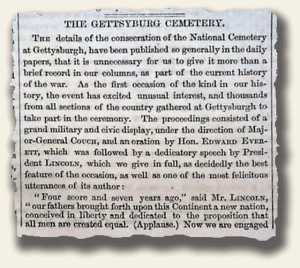 5) Baltimore Patriot, Sept. 20, 1814 First newspaper appearance of the Star Spangled Banner, and great to have in a Baltimore newspaper.
5) Baltimore Patriot, Sept. 20, 1814 First newspaper appearance of the Star Spangled Banner, and great to have in a Baltimore newspaper.
4) Gettysburg Address, November, 1863 This remains the most requested speech by our collectors–regardless of century–and is likely the most known by school children across the country. A front page account is best, such as the New York Times.
3) Louisiana Purchase, 1803 Who could argue with an event which doubled the size of the country.
2) Charleston Mercury–Extra, Dec. 20, 1860 It’s a broadside so perhaps some will argue not a bona fide newspaper, but we collect Extras as well so I include this notable issue. This newspaper’s “The Union is Dissolved” broadside was the first Confederate publication as South Carolina was the first state to secede. It went to press 15 minutes after the secession ordinance was passed.
1) The California Gold Rush in a California newspaper, 1849. Three California newspapers existed at the time so issues do exist yet extremely rare. Combining the great rarity with a event which did so much to spawn migration of the people across the country, and another very romanticized event in American history, and you get my top pick.
Lincoln establishes a national Thanksgiving Day…
November 26, 2009 by TimHughes · 1 Comment
Appropriate for this day we show photos of the official Proclamation by Abraham Lincoln establishing the “…last Thursday in November…” as a day of Thanksgiving.
In the midst of the Civil War and with the troubles the nation was facing, he thought it appropriate that: “…fellow citizens in every part of the United States…to act apart & observe…a day of Thanksgiving & Prayer to our beneficent Father…due to him for such singular deliverances and blessings, they do also, with humble penitence for our national…disobedience, commend to His tender care…implore the interposition of the Almighty hand to heal the wounds of the nation & to restore it...” (see photos).
This text appeared in the New York Daily Tribune of October 5, 1863. A beautifully written piece by the President in the midst of so much national turmoil & bloodshed. Please enjoy:
A modest resume…
November 23, 2009 by TimHughes · Leave a Comment
“The Crisis” newspaper from Columbus, Ohio, dated May 24, 1863 ran the piece on Lincoln shown in the photo. Keep in mind that this was a “copperhead” newspaper (northern paper opposed to the war, even advocating the continuance of slavery) so there was much criticism to Lincoln and his administration throughout it’s print run, so it is likely the piece was printed to emphasize the “modestness” of his resume.
From what we know of Abraham Lincoln this short piece he submitted, despite likely edits by the newspaper publisher, is largely correct and emphasizes the humble background of the man whom history arguably ranks as among the best of American Presidents. Certainly the trappings of wealth, family pedigree and the best of education which are traits common to leaders in other parts of the world are not prerequisites to success in America. This simple piece in a 146 year old newspaper is evidence that “the American dream” has been alive and well on this side of the Atlantic for many years.
